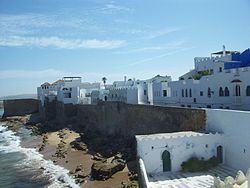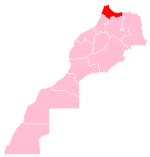Asilah
Asilah
أصيلة، ⴰⵥⵉⵍⴰ | |
|---|---|
 Asilah waterfront | |
| Country | |
| Region | Tanger-Tetouan-Al Hoceima |
| Population (2014)[1] | |
| • Total | 31,147 |
Asilah (Arabic: أصيلة، Aṣīla; Berber languages: ⴰⵥⵉⵍⴰ Aẓila; "authentic", Portuguese: Arzila, Spanish: Arcila) is a fortified town on the northwest tip of the Atlantic coast of Morocco, about 31 km (19 mi) south of Tangier. Its ramparts and gateworks remain fully intact.
History
The town's history dates back to 1500 B.C., when the Phoenicians used it as a base for trade.[2][3] The Portuguese conquered the city in 1471, but later it was decided to abandon it because of an economic debt crisis in 1549.[4] Later in 1578, Sebastian of Portugal used Asilah as a base town for his troops during a planned crusade that resulted in Sebastian's death, which in turn caused the Portuguese succession crisis of 1580. The Moroccans in 1589 regained control of Asilah briefly, but then lost control of it to the Spanish.[5]
In 1692, the town was again taken by the Moroccans under the leadership of Moulay Ismail. Asilah served then as a base for pirates in the 19th and 20th centuries, and in 1829, the Austrians punitively bombarded the city due to Moroccan piracy.[6]
From 1912 to 1956, it was part of Spanish Morocco. A major plan to restore the town was undertaken in 1978 by its mayor, Mohamed Benaissa. The first edition of an art festival known as the International Cultural Moussem of Asilah was launched that year to help generate tourism. It was successful in generating revenue for the city and played a role in raising the average monthly income from $50 in 1978 to $140 in 2014. The festival features local artwork and music and continues to attract large amounts of tourists.[7]
Asilah is now a popular seaside resort, with modern holiday apartment complexes on the coast road leading to the town from Tangier.[8]
Culture
Asilah hosts annual music and arts festivals, including a mural-painting festival.[8] Thursday is market day.[3]
The houses of Asilah features mashrabiya, and blue or green painted wood can be seen along the main narrow streets of the town. The main cultural center is the Centre Hassan II des Rencontres Internationales, which hosts festivals in the summer.[3] Among the events held in Asilah, is the International Cultural Festival.[5]
Gallery
-
Asilah's ramparts seen from the pier
-
Portuguese fortress
-
Street in Arzila
-
Portuguese fortress and houses
References
- ^ "Population Légale des Régions, Provinces, Préfectures, Municipalités, Arrondissements et Communes du Royaume Après les Résultats du RGPH 2014". Recensement Général de la Population et de l'Habitat 2014. Haut-Commissariat au Plan du Maroc. Retrieved 5 October 2016.
- ^ Priscilla Sacramento (24 May 2016). Invisible Threads. AuthorHouse UK. p. 204. ISBN 978-1-5246-3223-6.
- ^ a b c DK Publishing (29 November 2010). DK Eyewitness Travel Guide: Morocco. DK Publishing. p. 91. ISBN 978-0-7566-8665-9.
- ^ Jorge Nascimento Rodrigues; Tessaleno C. Devezas (1 December 2007). Pioneers of Globalization: Why the Portuguese Surprised the World. Centro Atlantico. p. 117. ISBN 978-989-615-056-3.
- ^ a b Paula Hardy; Mara Vorhees; Heidi Edsall (2005). Morocco. Lonely Planet. pp. 121–122. ISBN 978-1-74059-678-7.
- ^ "'Abd ar-Rasham". Encyclopedia Britannica. Vol. I: A-Ak - Bayes (15th ed.). Chicago, IL: Encyclopedia Britannica, Inc. 2010. p. 17. ISBN 978-1-59339-837-8.
- ^ Emma Katz (2014). "Art and the Economy in Amman". Journal of Georgetown University-Qatar Middle Eastern Studies Student Association. Globalization and the Middle East: Youth, Media & Resources, 7. doi:10.5339/messa.2014.7.
- ^ a b "The murals of Asilah". Euronews.com. Retrieved 19 July 2012.
- Former Portuguese colonies
- Kingdom of the Algarve
- Port cities and towns on the Moroccan Atlantic Coast
- Roman sites in Morocco
- Populated places in Tanger-Tetouan-Al Hoceima
- Populated places established in the 2nd millennium BC
- 1471 establishments in the Portuguese Empire
- 1549 disestablishments in the Portuguese Empire
- 1912 establishments in the Spanish Empire
- 1956 disestablishments in the Spanish Empire












